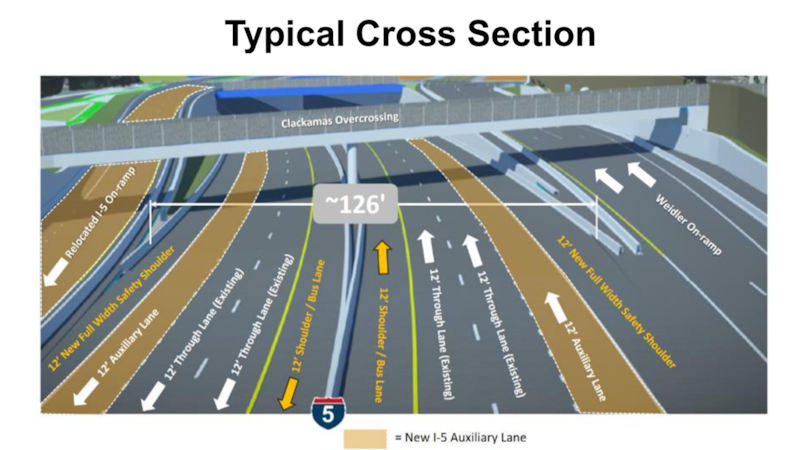The latest effort by state transportation officials to justify the width of an expanded Interstate 5 through the Rose Quarter includes something your average Portlander might like: dedicated bus lanes.
The Oregon Department of Transportation says it wants to build 12-foot shoulders along the existing highway so that buses can travel unimpeded in the center of I-5.
Just one problem: The idea caught some local government officials by surprise, including a representative of the regional transit agency that runs buses.
Steve Witter, the TriMet representative on the executive steering committee for the Rose Quarter project, expressed bafflement.
"Frankly, two minutes before this meeting, my team gave me a heads-up that this interior 12-foot bus lane was going to show up," Witter said at the March 22 meeting. "I'm not sure why this is there.…We don't operate a bus-on-shoulder."
That's correct: TriMet doesn't run its buses along the shoulders of highways—although C-Tran, the Clark County, Wash., public transit agency, does. In fact, TriMet rarely places its bus routes on interstate highways at all.
That meant ODOT's unveiling of the lanes last week felt like buying a birthday saddle for a kid who doesn't own a pony.
And that means open season for critics who detest the wide expanse of highway that ODOT wants to run through the center of Portland. As WW reported last month, the I-5 Rose Quarter project now spans at least 126 feet, not including on- and off-ramps, as it passes Harriet Tubman Middle School in the Rose Quarter.
"That's a 10-lane freeway; you can call those lanes whatever you want, but it's still a 10-lane freeway," says Joe Cortright, an economist and critic of the project who is part of the advocacy group No More Freeways PDX. "It's a long, long after-the-fact rationalization. If ODOT were serious about bus lanes, why wouldn't they be talking about bus lanes the full length of I-5?"
ODOT officials say they are working to improve the project and first raised the possibility of a bus-on-shoulder project last May at an Oregon Transportation Commission meeting.
The strongest evidence that Cortright is correct: At the southern end of the Rose Quarter project, ODOT plans to restripe the existing pavement: Four lanes will be turned into five by shrinking the width of some lanes and reducing the safety shoulder.
In other words, once you pave a highway, you can use it for any purpose you like with a little paint. Such purposes include one many Portlanders reject: room for more cars.
But politically more significant are the criticisms of the proposed bus lanes coming from Metro Council President Lynn Peterson, a traffic engineer who previously headed the Washington Department of Transportation.
"I haven't heard anyone from C-Tran or TriMet ask for an inside shoulder wide enough for buses. It's just not needed as part of this project," she tells WW.
Apart from skepticism that ODOT is sincerely adding bus lanes, Peterson says the problem is that a wider highway makes it more expensive to build caps above the freeway. Such caps would restore Albina, a Black neighborhood that was displaced decades ago.
"I want this project to stitch back the Albina community, not tear it apart," Peterson says, "which means having a lid that can be a base for development in a seamless pedestrian connection over I-5. Every added foot of width adds cost and, in this case, seemingly unnecessary cost. If ODOT is going to meet my expectations of restorative justice through this project, they need to do better."
Adding caps to make room for a new neighborhood over the highway is an idea that has significant political backing in Portland, and it's not yet clear how ODOT moves forward in the face of such objections.
ODOT officials say they're continuing to work to improve the project, including a decision not to widen the highway in one portion but rather create more lanes with narrower shoulders. "The project design has already incorporated several changes based on input from project partners and the community, including a change that reduces impacts to the Eastbank Esplanade," says Megan Channell, ODOT's Rose Quarter project director.
One possible problem for ODOT with revising the project's design now: Delays could cost the department more money.
